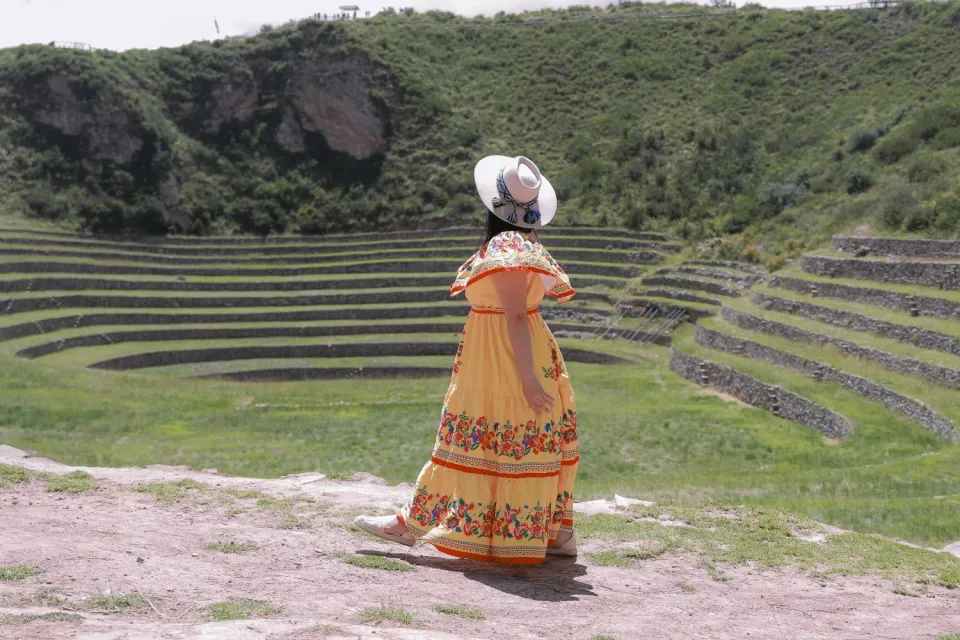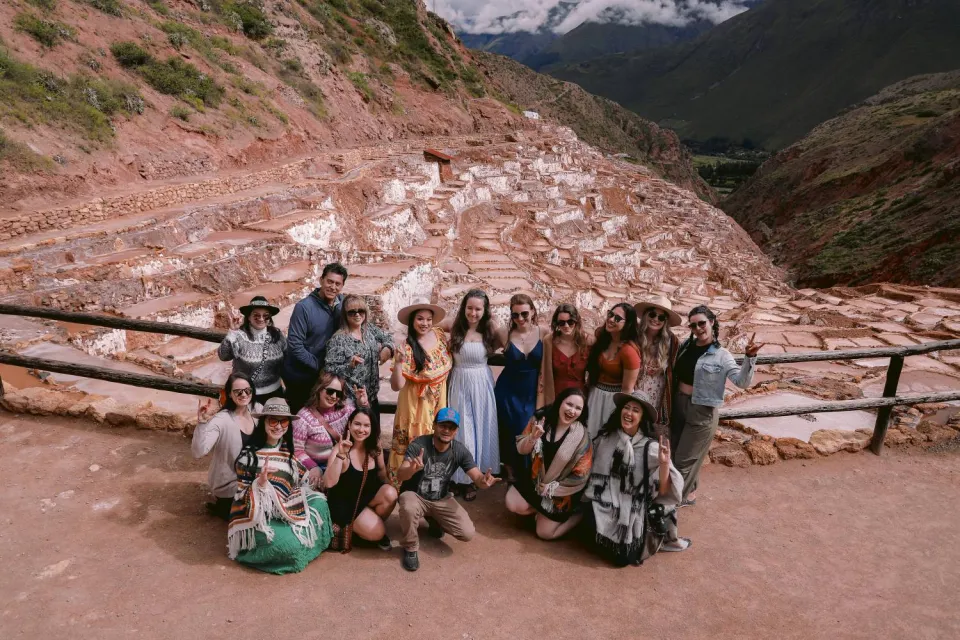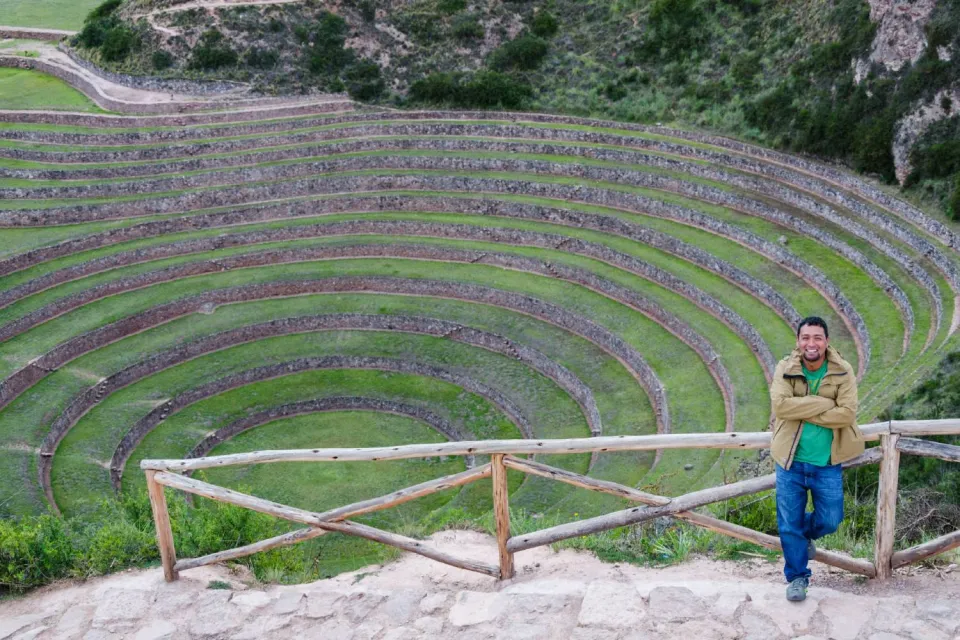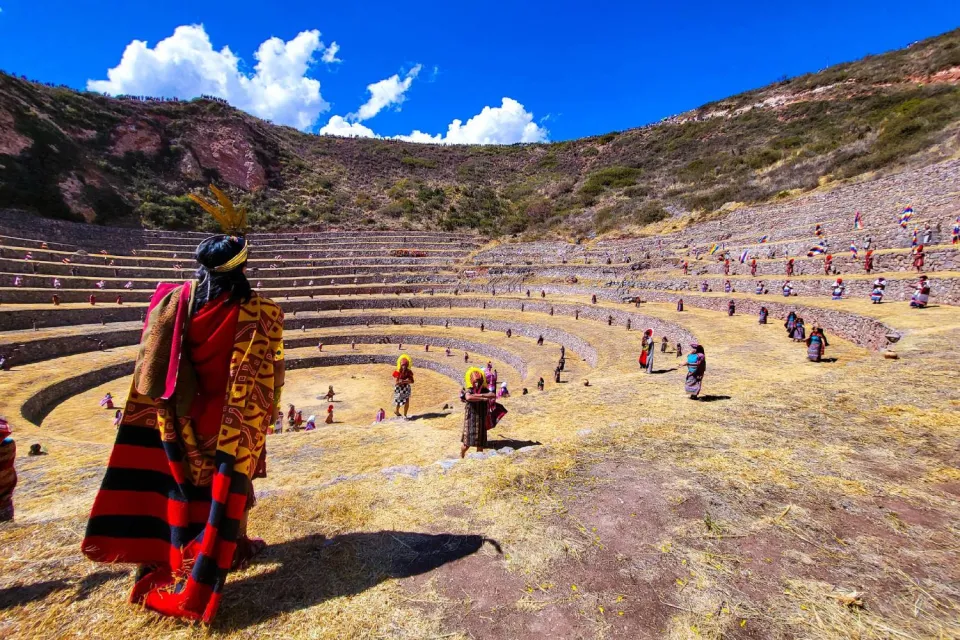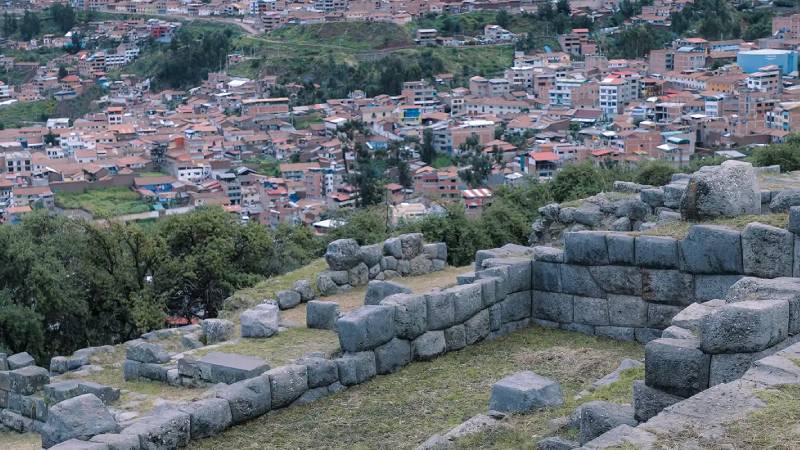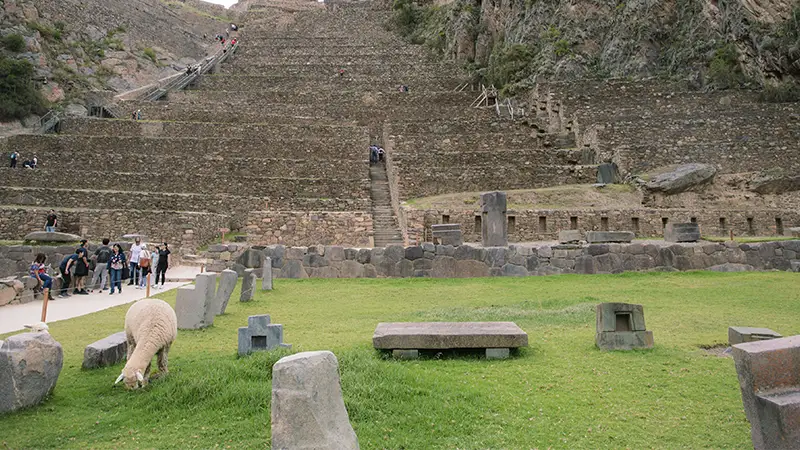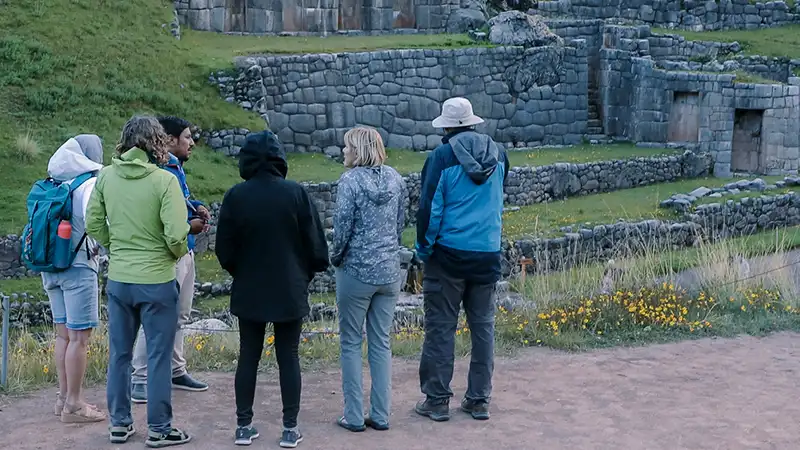Maras-Moray are two of the most surprising and enigmatic destinations in the Sacred Valley of the Incas.
In this blog, you will discover how the Incas created microclimates in circular terraces to cultivate species that normally wouldn't survive in the Andes.
We will also explore the impressive salt mines of Maras, a system of salt ponds in operation since pre-Inca times.
Moreover, these places not only stand out for their fascinating history and unique architecture, but also for their landscapes that seem to be taken from another world.
So, what secrets do these ancient lands really hide? Join us to unveil them.
Maras-Moray Location
Maras and Moray are located in the province of Urubamba, 48 km northwest of Cusco, Peru.
At 3,384 m.a.s.l., this destination accessible from Cusco through different routes, one of them is by road with an approximate travel time of 60 minutes.
How to get to Maras-Moray?
In order to access these two places, there are three main access routes:
- Route Cusco - Izcuchaca - Huaypo - Chequerec - Maras (49 km)
- Route through Cruzpata - Chequerec - Maras communities
- Paved road Cusco - Urubamba
Climate in Maras-Moray
The climate of the city of Cusco is quite similar to that of the Sacred Valley; however, the latter is warmer.
Specifically, the climate of Maras-Moray is temperate and dry, with two well-defined seasons:
- Dry season (April to September): daytime temperatures of up to 21°C per day and nighttime temperatures of 5 °C .
- Rainy season (October to March): Daytime temperatures around 18°C, with frequent rainfall and nighttime temperatures of 10 °C.
What is the best time to visit Maras-Moray?
The best time to visit Maras-Moray depends on the preferences of each traveler.
Most tourists prefer the dry season, as it allows them to tour the sites without rain and enjoy clear, blue skies.
On the other hand, some travelers prefer lush landscapes and vibrant flora with fewer tourist.
For them, the rainy season is ideal, since it also offers better prices and travel promotions.
Recommendation: If you are looking for green landscapes with little rain for your photographs, the ideal months to visit Maras-Moray are April and May.
Flora and fauna of Maras-Moray
The flora you will find in the sacred valley will be the chilka, cactus, alder, eucalyptus, tara, wheat, corn, apple and quince, predominantly Andean vegetation.
Moreover, visitors will be able to see a wide variety of fauna.
Among the animals you can observe are toads, Andean deer (tarucas), foxes, kestrels, hummingbirds, guinea pigs, skunks, llutu, sparrows, and cuculi, among other species characteristic of the Peruvian highlands.
History of Maras-Moray
History of the salt mines of Maras
The salt mines of Maras have existed for many years. They originate from the summits of the Qaqaqiñay mountain, where salty waters flow. As the sun evaporates the water, natural salt wells form.
Another origin of the salt wells of Maras comes from a legend that tells that the salty waters of the wells are the tears of Ayar Cachi.
According to Inca mythology, Ayar Cachi was one of the four Ayar brothers. Following the mandate of the god Wiracocha, they set out on a journey with their wives.
Their mission was to find the ideal place to establish what would become the Inca Empire.
On the way, Ayar Cachi threw a stone with such force that it formed a ravine.
His brothers, fearful of his great power, deceived him and locked him in a cave to prevent him from becoming the founder of the empire.
It is said that, when he was imprisoned, Ayar Cachi shed tears that gave birth to the salt pools. As time passed, the sun dried these waters, thus forming the current salt flats of Maras.
History of Moray
According to the latest research, the first terraces of Moray were built by a pre-Inca culture between the 6th and 10th centuries, possibly by the Maras culture, which dominated the region.
During the Inca Empire, Moray became a center of agricultural experimentation. The Incas transformed these terraces into circular terraces, designed to create microclimates and improve crop yields.
They also implemented irrigation canals to optimize irrigation. All this occurred between the 12th and 14th centuries, during the territorial expansion of the Inca Pachacutec.
With the arrival of the Spaniards, this place fell into oblivion.
It was not until 1932 that it was rediscovered by Shirppe Johnson, who flew over the area and found it covered with vegetation.
The Unique Terracing System
The Terraces of Moray are one of the greatest enigmas of Inca engineering.
This archaeological center, made up of several circular terraces, stands out for its impressive design and its possible use as a pre-Hispanic agricultural laboratory.
In Moray, four large amphitheater-shaped depressions can be observed, the deepest of which reaches approximately 45 meters.
Each of the terraces has a drop of 1.80 meters, which generates significant temperature variations between levels.
Thanks to this system, the Incas were able to recreate microclimates, making it possible to grow up to 250 plant species.
Many of these species would not have naturally survived in this region without these agricultural innovations.
Agricultural techniques used in Moray
The Incas were masters at developing advanced agricultural techniques, adapting their environment to maximize food production under extreme conditions.
Moray are impressive examples of their knowledge of agricultural engineering and water management, allowing them to cultivate a wide variety of species in the Andes.
Artificial microclimates in Moray
In the archaeological center of Moray, the Incas created a system of staggered circular terraces, where each level presented a different climatic variation.
These temperature differences between terraces could reach up to 15 °C, which made it possible to simulate different ecosystems and to cultivate species typical of warmer climates, such as corn and coca.
To achieve this, they built retaining walls that retained moisture and protected the crops from erosion.
In addition, each terrace was filled with soils brought from different regions, ensuring the diversity of nutrients necessary for the growth of different plants.
Drainage and irrigation system
One of the most innovative aspects of Moray is its natural drainage system, which prevents water accumulation and protects the terraces from flooding.
The Incas likely used subway channels to filter rainwater, distributing it evenly throughout the terraces based on each crop’s needs.
The Incas also applied their astronomical knowledge to agricultural techniques, using Moray as a climate observation center.
This would have allowed them to predict the seasons, adjust planting cycles and improve crop yields.
The agricultural legacy of Maras and Moray remains a showcase of Inca ingenuity, combining science, technology and a deep respect for nature to ensure the food security of their civilization.
However, some researchers suggest that Moray not only functioned as an agricultural center, but may also have served as an astronomical observatory.
According to this theory, the Incas would have used the terraces to monitor the weather and predict natural phenomena based on the position of the sun and stars.
Whatever its true purpose, Moray remains an impressive testimony to Inca wisdom, combining knowledge of agriculture, engineering and astronomy in one place.
A site that undoubtedly continues to amaze all visitors.
Maras-Moray entrance ticket
Is an entrance ticket required for Moray?
Yes, the entrance to Moray is done through the Integral Cusco Tourist Ticket, which costs 130 soles for foreign tourists and 70 soles for national tourists.
You can also enter with the Partial Cusco Tourist Ticket III, which costs 70 soles for foreigners and 40 soles for Peruvians.
You can choose the ticket that best suits your needs. However, the purchase can only be made in person at the Cosituc offices.
The main office is located at Av. El Sol 103, office 10, or directly at the entrance to Moray. Its opening hours are from 8:00 a.m. to 5:00 p.m.. Also, authorized agencies can purchase the ticket for you.
Is an entrance ticket required for Maras?
Access to Maras requires the purchase of a ticket at the entrance of the enclosure.
The approximate cost is 15 soles for foreign tourists and 10 soles for Peruvians.
In addition, the opening hours of the Maras salt mines are from 8:00 a.m. to 5:00 p.m..
Tips to have the best experience in Maras-Moray
- Don't forget to bring your ID or passport to enter the site.
- Visit early to avoid the crowds and enjoy the sunrise.
- Wear comfortable clothes and layers as the weather is changeable.
- Wear sunscreen and sunglasses to avoid sunburn due to the high solar radiation from the altitude.
- Carry a small backpack with items such as medicine for the soroche, water and snacks.
- Hire a tour guide to make the most of your visit with detailed information and without worries.
Recommendations for visiting Maras and Moray
- Follow the signs at the archaeological sites to avoid getting lost inside them.
- Do not touch the stones, as some of them could be just overlapping.
- Do not lean or climb on the walls, as you could cause them to collapse and get hurt.
Cultural events in Maras
Wata Qallariy: The Beginning of the Andean New Year
Every August 1st, the people of Moray celebrate the Wata Qallariy, a festivity that marks the beginning of the Andean New Year.
This event takes place on the impressive terraces of Moray and is full of color, music and tradition.
During the celebration, the inhabitants of the area participate with Andean dances and music, paying homage to the Pachamama through the traditional payment to the earth, an offering of gratitude for fertility and abundance.
Moray Raymi: The Sun Festival
In October, the villagers celebrate Moray Raymi, also known as the Festival of the Sun.
During this festivity, they represent scenes related to Mother Earth as a sign of gratitude for the harvests.
This event includes folkloric dances typical of the region and a staging that highlights the ancestral connection between the inhabitants and nature.
Both festivities are a unique opportunity to experience Andean culture up close and understand the deep relationship that the community maintains with its environment.
Maras-Moray is much more than an archaeological site. It is a testimony of Inca grandeur, a place where history and nature meet in perfect harmony. Come explore it and discover its mysteries for yourself!
Frequently Asked Questions
- What does Moray mean?
The term “Moray” comes from the Quechua “Aymoray”, associated with the month of May, or from the combination of “Muyu” (round) and “Uray” (down), which means “sunken territory”.
- What is the maximum visiting time in Moray?
The maximum visit time is 2 hours, allowing time to explore its circular terraces and learn about its history.
- What is the maximum visiting time in Maras?
The maximum visit time is approximately 1 hour, enough time to explore the site and learn about the salt extraction process.
- Can I do the tour on my own?
Yes, it is possible to do the tour on your own.
However, the main difficulty will be to find transportation to get to both places, as there is no direct service.
Furthermore, you will have to arrange the purchase of entrance tickets on your own.
- How is Maras salt extracted?
The salt is extracted from the ponds after five days, by lightly scraping it with a board.
Then, the salt is transferred for drying in the shade, allowing the water to drain completely. Finally, the salt is packaged before being sent to market.
- What materials are used for salt extraction?
Materials used in salt extraction include:
- Kisuna: a eucalyptus board between 50 and 80 cm long by 15 cm wide, used to scrape the salt.
- Metal shovel: used to collect the extracted salt.
- Willina basket: used to transport the salt.

